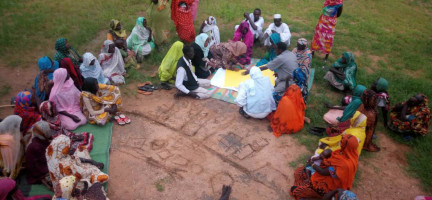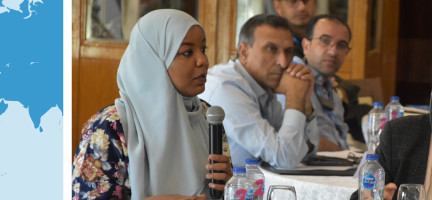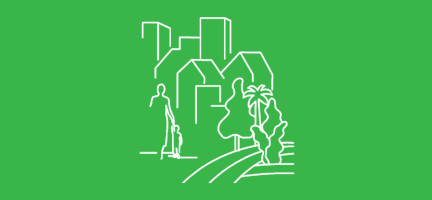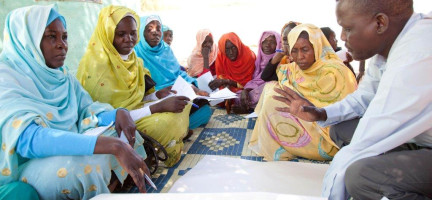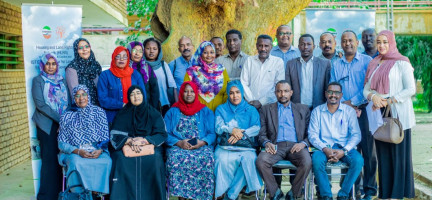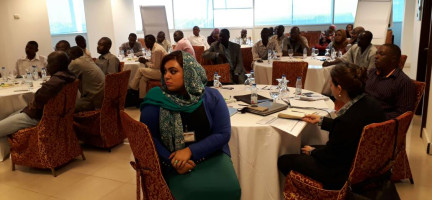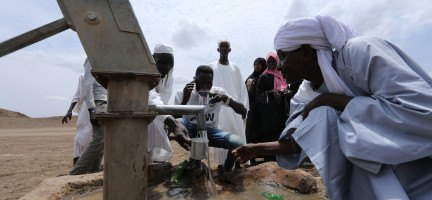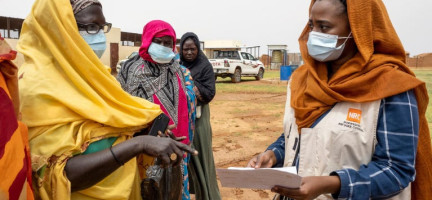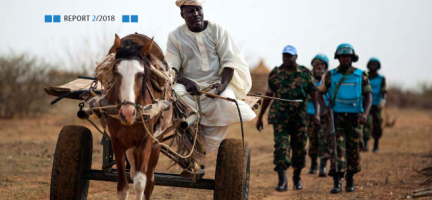Sudan
A Land of Diversity and Rich History
Situated in Northeast Africa, Sudan boasts a rich historical legacy and a diverse population estimated at 46,874,204. This vast country, covering 1.88 million km², was the largest in Africa prior to South Sudan’s secession in 2011. Khartoum, the capital, lies at the confluence of the White Nile and Blue Nile, giving birth to the iconic Nile River—the lifeblood of the region.
Sudan’s cultural tapestry is woven from various influences, making it a land of natural and social ethnic diversity. It shares borders with neighboring countries such as Egypt, Eritrea, Ethiopia, the Central African Republic, Chad, Libya and South Sudan. As the third-largest country in Africa, Sudan’s landscape and heritage continue to captivate and inspire (UNEP, 2020).
Urbanization and natural resources
Despite being predominantly desert and semi-desert, Sudan’s natural resources are the backbone of its economy.
Approximately 30-35 per cent of Sudan’s GDP stems from agriculture, which also provides livelihoods for around 65 per cent of the population (World Bank, 2016) and employs about 50 per cent of the labor force. The country is rapidly urbanizing, though most of Sudan’s residents currently live in rural areas. Khartoum, Sudan’s largest city, grew at an annual rate of 5 per cent between 1973 and 1993, and at an even higher rate between 1993 to 2006. Many Sudanese have moved to urban areas in search of employment opportunities and better lives, while others have been driven there by drought and famine in Kordofan and Darfur.
Sudan’s historical significance and abundant natural resources coexist with formidable challenges: a significant portion of the population lives in poverty and struggles to meet basic needs, experiencing food insecurity and malnutrition; Environmental degradation and desertification pose threats to livelihoods; Sudan also grapples with human rights abuses, particularly during periods of political instability (UNEP, 2020,).
Cultural Mosaic
Sudan’s cultural fabric is a vibrant mosaic, reflecting both its Arabic-Islamic heritage in the north and its African languages and traditions in the south. The country boasts a remarkable ethnic and linguistic diversity, with approximately 300 tribes and 100 dialects, as well as a multitude of geographical and environmental features (UNEP, 2020). Islam is the largest religion in Sudan with a Muslim population of 97 per cent, including numerous Arab and non-Arab groups.
HLP issues and Displacement
Sudan is currently undergoing a turbulent journey of political upheaval and displacement. In April 2019, Sudan experienced a seismic political shift and widespread civil unrest. After three decades of rule, the entrenched political regime was overthrown following massive protests. A civilian-led transitional government emerged through a delicate power-sharing arrangement between military and civilian leaders.
However, this fragile progress was shattered in October 2021 when a military coup ousted the civilian-led transitional government. Amidst this political turmoil, a civil war erupted between Sudan’s military and the paramilitary Rapid Support Forces (RSF). The consequences have been dire, as Sudan now faces one of the most significant displacement crises globally. With over 5.4 million internally displaced people (IDPs) and more than 1.4 million refugees crossing borders as of January 2024 (UNHCR, 2024), the scale of human displacement is staggering. Violence has taken countless lives, compelling people to flee their homes in search of safety. Additionally, the prolonged conflict in the Darfur region, which began in 2003, resulted in 1.86 million internally displaced persons, many of whom sought relocation in towns in urgent need of humanitarian support.
The current conflict has caused widespread destruction and displacement, affecting the housing, land and property (HLP) rights of millions of people. Common HLP issues include loss of property documents, tenure insecurity, forced evictions, secondary occupation and land grabbing. Sudan is also vulnerable to the effects of climate change, such as floods, droughts and desertification, which worsen environmental degradation and resource-based conflicts. HLP issues in these contexts include land use conflicts, climate change impacts, access to resources and displacement due to environmental factors.
Legal and institutional frameworks
The legal framework governing land in Sudan is a complex blend of statutory law and customary law, which have evolved over time with little coordination between the two. Unfortunately, there is no unified legal framework for land tenure across the entire country. Most of the land in Sudan is held under a customary tenure system, which remains unmapped and undermarketed, while local customs and practices related to land tenure vary across different parts of Sudan.
The Unregistered Land Act of 1970 and the Civil Transaction Act of 1984 in Sudan have significant implications for land ownership and rights in designation of unregistered land. Both acts classify all unregistered land as state land, while there is no formal legitimacy or juridical status for customary land rights. The acts also explicitly authorize the government to expropriate and evict occupants from unregistered lands. As a result, under these laws, approximately 90 per cent of unregistered land in Sudan is effectively owned by the government. Individuals and entities can still obtain leasehold interests in land, which come with varying durations and terms, allowing for use without full ownership. Since the 1994 Land Act, several national strategies that include urban planning components have been developed. However, there is no stand-alone national urban policy or national spatial planning strategy in place.
Institutions that support land planning and management exist at both the national and state levels in Sudan. At the national level institutions include the National Land Commission, established by the Constitution in 2005, though it is not yet fully functional; State planning committees, which were established to coordinate and oversee physical planning and development, and the National Council for Physical Development (NCPD) develops policies, strategies, and reviews master plans created by states, as well as the Ministry of Urban Development Roads and Bridges. At state level The Ministry of Urban Planning and Infrastructure (MoUPI) is responsible for implementing the Physical Planning and Land Disposal Act of 1994. It handles various land-related processes, including surveying, planning, land-use management, building, monitoring and controlling housing development settlements (UN Habitat/GLTN, 2020).
Land use
The 1947 Town Land Regulation Act introduced three categories of land-use zoning and land subdivision regulations. In urban areas, this act established various plot sizes associated with different lease periods, while other regulations, which often change, accompany the Act. For residential properties, there are three grades of registered land leases. Grade I, which is commonly distributed to high-ranking officials and through auctions, sets a minimum area for properties at 500-800 square meters, with a permanent and multi-story building type. Grade II is typically allocated to mid-class civil servants, with minimum area of 400-500 square meters a permanent building type. Grade III is distributed to civil servants at labor grades. These properties have a minimum area of 200-300 square meters, and the building type is constructed with local materials. All villages fall under Grade VI, as per the National Council of Physical Development. Furthermore, there are other types of leases for commercial zones, investment land and other specific contexts (UN Habitat/GLTN, 2020).
Women and land
Women face severe discrimination and violation of their land rights under both statutory and customary systems, especially regarding land ownership and inheritance. Women are often unaware of their land rights under statutory law, Islamic law and human rights norms, and face barriers to access legal aid and dispute resolution mechanisms. In many cases women who own land transfer the title to male members of the household, due to custom and tradition (. The existing laws and policies do not adequately protect women’s land rights or address the gender gaps in land governance. Women are more vulnerable to land dispossession, forced evictions and human rights abuses during and after conflict, especially as female-headed households. They face challenges to access land and secure tenure in their places of refuge or return, and to claim restitution or compensation for their lost land.
Land value
The government imposes specific taxes related to land and associated transactions, tax measures play a crucial role in the country’s revenue collection and management of land-related financial transactions. These include Leasing Income Tax: Rate: 10 per cent This tax is levied on income generated from land leases. Capital Gains Tax: Rate: 5 per cent It applies to gains resulting from the sale of lands and buildings. Rentals Tax: Rate: 10 per cent Threshold: This tax is applicable to rental sums exceeding certain amount (IGAD).
Land development
The delivery of planned, surveyed plots in urban areas with emphasis on Khartoum is revenue driven; the Ministry of Finance is the main driver of land development as it sees land sales as a way of generating funds quickly to cover the state’s budget deficit. The Ministry of Finance instructs the other ministries, particularly MoUPI and the Ministry of Agriculture, to plan and sell land to people. Prices are high in major cities and relatively low in rural areas, though most buyers do not intend to develop the land, which results in large numbers of planned plots being left vacant and undeveloped. Land authorities focus on planning and selling land plots, however, they do not give sufficient attention to longer term land use management. Further, the supply of registered land is somewhat linked to people who have connections and access to the official system. This adds a layer of complexity for IDPs, returnees and poor people, who are less educated and less connected in general. Consequently, land has become a commodity, a mechanism of socioeconomic differentiation and a cause of poverty and conflict in Sudan. To address resource-based conflicts effectively, land issues must be tackled within a wider context, including socioeconomic, political, cultural, judicial and institutional aspects (UN Habitat/GLTN, 2020).
Land conflict resolution
Land conflict resolution mechanisms in Sudan vary from traditional, statutory to hybrid mechanisms. The traditional mechanism (Judiyya) consists of a mediation system using third-party mediators. However, this system faces challenges, including a lack of legal recognition, political interference and limited capacity for complex conflicts. In contrast, statutory mechanisms are backed by a formal legal system consisting of courts, arbitration committees and land commissions. Challenges to the statutory system include accessibility, affordability, transparency, legitimacy, corruption and inefficiency issues. Hybrid mechanisms are recently formulated, combining traditional and statutory elements to bridge gaps and bring potential benefits of inclusivity and effectiveness (Land Portal, 2022).
Key Interventions
1-Darfur land administration assessment report/ findings, recommendations and relevance to the recent humanitarian recovery context in Sudan
In 2020 the Darfur Land Administration Assessment report was published by UN-Habitat and GLTN, with objectives to assess the statutory and customary land administration systems and practices in the five Darfur states of Sudan. It also aims to provide guidance to relevant stakeholders on how to support the tenure security and HLP rights of people voluntarily returning to Darfur and of other vulnerable people, such as IDPs, refugees, women and youth.
The Darfur Land Administration Assessment report is a pivotal document aimed at fostering stability and equitable land rights in Darfur. It underscores the urgency of securing land and property rights for vulnerable and marginalized groups.
The report illuminates key deficiencies within the land administration systems across Darfur's states and advocates for the harmonization of statutory and customary land tenure frameworks. It proposes number of recommendations, with a focus on protecting HLP rights, advancing land governance through tangible measures in land-use planning and administration, improving the systems for land data acquisition, storage and distribution, enhancing the efficiency and fairness of land dispute resolution processes and developing comprehensive training and capacity enhancement programs for land governance personnel.
The recommendations outlined in the Darfur Land Administration Assessment report play a crucial role in addressing the recent challenges related to HLP in Sudan after the violent conflicts that erupted on 15th of April 2023. Some key take aways are:
Securing Rights and Stability: The report emphasizes securing HLP rights for vulnerable groups, including returnees, internally displaced persons (IDPs) and refugees. By ensuring tenure security, individuals and communities can rebuild their lives with confidence. Clear HLP rights contribute to overall stability: when people have secure access to land and property, it fosters trust, reduces tensions and promotes social cohesion.
Post-Conflict Recovery and Reconstruction: Implementing effective land governance mechanisms is essential for rebuilding communities. Proper land-use planning, transparent land administration and efficient dispute resolution systems are critical. Moreover, secure HLP rights attract investment and facilitate development, as investors and businesses require clarity on land ownership and usage to participate in reconstruction efforts.
Humanitarian Assistance and Resilience: During emergency and post-conflict situations, access to humanitarian aid is vital. Clear HLP rights enable aid agencies to target assistance effectively, especially for housing reconstruction and livelihood restoration. Hence, strengthening HLP systems enhances community resilience. When people have legal recognition of their land and property, they are better equipped to withstand future shocks.
Gender Equality and Social Justice: The report highlights the importance of gender sensitive HLP policies. Ensuring women’s equal access to land and property is crucial for their empowerment and well-being, considering the historical inequalities in land distribution, to promote social justice and inclusivity.
2-Promote Peace Building and Stability in the Blue Nile
In 2018, UN-Habitat with support of the Embassy of Norway, provided support to conflict-affected people in Ad-Damazine Locality, Blue Nile State, including IDPs, vulnerable families and women’s groups, to ensure access to and use of secured, planned land parcels, to increase access to water and basic sanitation, education and health services and to improve self-reliance through access to socio-economic activities.
3- Transition To Sustainable Peace and Social Cohesion in the Blue Nile
In 2023, with the support of the Embassy of Norway, UN-Habitat undertook a significant initiative involving sketch mapping in 20 villages across four governorates. Community-based fit-for-purpose approaches and tools were employed to achieve this goal. The project encompassed several key activities including demarcation of boundaries, urban area mapping, identifying land for relocation and capacity building. The capacity building activities focused on enhancing the technical skills of the Ministry of Urban Planning and Infrastructure staff, including mapping techniques and the practical application of fit-for-purpose approaches. This comprehensive effort contributed to improved land management and sustainable urban development.
4- Strengthening Land Management for Peaceful Co-Existence in Darfur
This intervention, carried out between 2015 and 2018, aimed to enhance the existing land title system in Darfur and contribute to the development of evidence-based land policies, laws and regulations. UN-Habitat actively facilitated the sustainable return of IDPs in Darfur through close collaboration with the Darfur Land Commission (DLC), the Voluntary Return and Resettlement Commission (VRRC) and relevant ministries across the five Darfur states. This project was successfully implemented in 51 villages within Darfur, ensuring secure land tenure for the returning IDPs.
References
IGAD. Sudan – Land Governance Country Profile
Land Portal (2022). Sudan
UNEP. Sudan First State of Environment and Outlook Report 2020
UN Habitat/GLTN (2020). Darfur Land Administration Assessment: Analysis and Recommendations
UN Habitat (2016). Country Profile: Sudan
UN Habitat. The Government of Norway & UN-Habitat Partnership Profile in Sudan 2019
UN Habitat. The Government of Japan & UN-Habitat Partnership Profile in Sudan 2019
UN Habitat. The Government of Qatar & UN-Habitat Partnership Profile in Sudan 2019
UNHCR. Sudan Situation Supplementary Appeal 2024
UN Sudan (November 2022). Common Country Analysis
World Bank. Enabling The Business of Agriculture 2016: Comparing Regulatory Good Practices
Disclaimer
The information contained in this page is based on the body of knowledge developed by UN-Habitat, GLTN and the Arab Land Initiative’s partners. The designations employed and the presentation of the material do not imply the expression of any opinion whatsoever on the part of the Secretariat of the United Nations concerning the legal status of any country, territory, city or area, or of its authorities, or concerning delimitation of its frontiers or boundaries, or regarding its economic system or degree of development. The information may contain inaccuracies due to the data source(s) and do not necessarily reflect the views of UN-Habitat or its governing bodies.
The Sudan page is still under construction. Share with us any relevant information, resource or correction to enrich our library. Contact the Arab Land Initiative at unhabitat-arablandinitiative@un.org !
